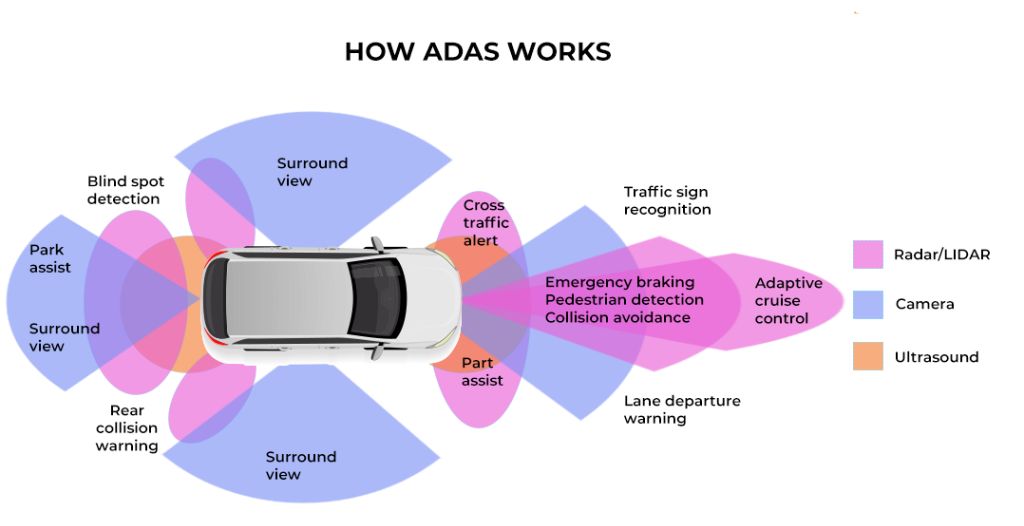Advanced Driver Assistance Systems (ADAS) have revolutionized the automotive industry by incorporating cutting-edge technologies to enhance driving safety and convenience. ADAS utilizes a range of sensors, cameras, and sophisticated devices to detect potential hazards and assist drivers in avoiding accidents or collisions.
With features like lane departure warning, adaptive cruise control, automatic emergency braking, and blind spot detection, ADAS technology aims to keep drivers focused on the road and ensure their safety.
How ADAS Works?

ADAS technology operates through a combination of systems, sensors, and electronic control units (ECUs). These systems include cameras, radars, LIDARs, ultrasonic sensors, GPS, and wheel encoders, which provide the vehicle with a comprehensive understanding of its surroundings.
The sensors gather data, which is then processed by the ECUs. The ECUs communicate with various vehicle components and make critical decisions to adjust the car’s movements accordingly, ensuring safe and efficient driving.
ADAS Levels of Automation
The Society of Automotive Engineers (SAE) has defined six levels of driving automation that classify the capabilities of ADAS systems:
Level 0: No Automation – The driver is fully responsible for all aspects of driving, and there is no automation involved.
Level 1: Driver Assistance – The vehicle features one automated system, such as cruise control or lane departure warning, to assist the driver.
Level 2: Partial Automation – The vehicle incorporates two or more automated systems that work together to assist the driver with steering, braking, and acceleration.
Level 3: Conditional Automation – The vehicle can manage most aspects of driving but requires the driver to be prepared to take control if necessary.
Level 4: High Automation – The vehicle can perform all driving tasks under certain conditions, such as on a highway or in a specific geographic area.
Level 5: Full Automation – The vehicle can perform all driving tasks in any situation without any human intervention.
Active ADAS vs. Passive ADAS
ADAS can be categorized into two main types: active and passive. Active ADAS systems actively intervene to prevent accidents, while passive ADAS systems provide feedback after an accident occurs.
Active systems, such as automatic emergency braking and lane departure warning, detect potential hazards and take corrective action. In contrast, passive systems, including airbags, seat belts, and reinforced vehicle structures, offer protection but do not directly intervene in accident prevention.
Different Types of ADAS Sensors
ADAS relies on various sensors to gather information about the vehicle’s surroundings. These sensors work together to provide a comprehensive view and detect potential hazards. The main types of ADAS sensors include:
1. Radar: Uses radio waves to detect objects, measure distance, speed, and direction of movement.
2. LIDAR: Utilizes laser light to create a detailed 3D map of the surroundings, enabling precise object detection.
3. Camera: Employs optical sensors to capture images, providing information about lane markings, traffic signs, and other vehicles.
4. Ultrasonic: Uses high-frequency sound waves to detect objects and measure their distance.
5. Infrared: Utilizes heat-sensitive sensors to detect objects, especially in low-light conditions.
6. GPS: Relies on satellite signals to determine the vehicle’s location, speed, and direction of movement.
Different ADAS Features
ADAS encompasses a wide range of features designed to enhance driving safety and convenience. Here are some commonly found ADAS features:
1. Adaptive Cruise Control: Automatically adjusts the vehicle’s speed and maintains a safe distance from the vehicle ahead.
2. Glare-Free High Beam and Pixel Light: Optimizes headlight illumination for maximum visibility while avoiding dazzling other drivers.
3. Automatic Parking: Assists in parking by automatically steering the vehicle into a parking spot.
4. Navigation System: Provides real-time directions, traffic information, and alternative routes to help drivers reach their destination efficiently.
5. Lane Departure Warning (LDW): Alerts the driver when the vehicle unintentionally drifts out of its lane without using the turn signal.
6. Blind Spot Detection (BSD): Warns the driver when there is a vehicle in the blind spot, helping to prevent lane-change collisions.
7. Forward Collision Warning (FCW): Alerts the driver of an imminent collision with the vehicle ahead, allowing them to take evasive action.
8. Automatic Emergency Braking (AEB): Automatically applies the brakes if a potential collision is detected and the driver fails to respond in time.
9. Pedestrian Detection: Uses sensors and cameras to identify pedestrians and warns the driver or applies the brakes to prevent accidents.
10. Traffic Sign Recognition (TSR): Identifies and interprets traffic signs, displaying them on the vehicle’s dashboard, helping drivers stay informed about speed limits, no-entry signs, and more.
11. Rearview Camera: Provides a live video feed of the area behind the vehicle, assisting drivers in parking and reversing maneuvers.
12. Driver Drowsiness Detection: Monitors the driver’s behavior, such as steering patterns and eye movements, to detect signs of drowsiness or distraction, issuing warnings to prevent accidents.
13. Cross-Traffic Alert (CTA): Notifies the driver of approaching vehicles or pedestrians when reversing out of a parking spot, reducing the risk of collisions.
Benefits of ADAS
The integration of ADAS technology in vehicles offers numerous benefits, including:
1. Improved Safety: ADAS features enhance driver awareness, reduce the risk of accidents, and mitigate the severity of collisions, making roads safer for everyone.
2. Enhanced Driver Assistance: ADAS systems provide assistance, reducing driver fatigue and workload, resulting in a more comfortable driving experience.
3. Efficient Driving: Features like adaptive cruise control and navigation systems optimize driving routes, reducing fuel consumption and emissions.
4. Collision Avoidance: ADAS can detect and respond to potential collisions faster than human reaction time, helping prevent accidents.
5. Increased Awareness: ADAS sensors provide a broader view of the surroundings, detecting objects that may be difficult for drivers to see, such as vehicles in blind spots.
6. Accessibility: ADAS technology can assist drivers with disabilities or age-related limitations, enabling them to drive safely and independently.
7. Insurance Benefits: Some insurance providers offer discounts for vehicles equipped with ADAS, as they are associated with lower accident rates.
Challenges and Considerations
While ADAS technology offers numerous benefits, there are also challenges and considerations that need to be addressed:
1. Reliance on Technology: ADAS systems heavily rely on sensors, cameras, and complex algorithms. Any malfunctions or failures in these components can affect the accuracy and reliability of the system.
2. Calibration and Maintenance: ADAS systems require regular calibration and maintenance to ensure optimal performance. If not calibrated correctly or maintained adequately, the system’s accuracy may be compromised.
3. Environmental Factors: ADAS systems can be influenced by environmental conditions such as heavy rain, snow, fog, or glare. These factors may reduce the effectiveness of sensors and cameras, affecting the system’s performance.
4. Driver Understanding and Education: It is crucial for drivers to understand the limitations and capabilities of ADAS technology. Misinterpretation or overreliance on the system can lead to complacency or false expectations, potentially resulting in accidents.
5. Cost: The integration of ADAS features can increase the overall cost of a vehicle. While the prices of these technologies are gradually decreasing, affordability and accessibility remain a consideration for widespread adoption.
6. Legal and Regulatory Framework: As ADAS technology advances, legal and regulatory frameworks need to keep pace to address liability, data privacy, and ethical considerations. The responsibility for accidents or system failures may become a complex issue.
7. Transition Period: During the transition period from conventional vehicles to fully autonomous vehicles, there will be a mix of vehicles with varying levels of automation on the road. Coordinating and ensuring safe interactions between these vehicles will be a significant challenge.
8. Ethical Decisions: In scenarios where a collision is unavoidable, ADAS systems may need to make split-second decisions that involve ethical considerations, such as choosing between protecting the vehicle occupants or minimizing harm to pedestrians or other road users.
Continuous Development and Collaboration
To overcome these challenges, continuous development, collaboration, and standardization are necessary. Manufacturers, policymakers, and technology developers need to work together to establish industry standards, improve system reliability, address regulatory concerns, and ensure the safe integration of ADAS technology into vehicles.
Moreover, ongoing research and development are crucial to refine existing features, introduce new capabilities, and enhance the overall performance of ADAS systems. This includes advancements in sensor technology, machine learning algorithms, and connectivity to enable more accurate and reliable decision-making in real-time driving scenarios.
Conclusion: ADAS technology has transformed the automotive industry, significantly improving safety and driver assistance. With its range of features and capabilities, ADAS enhances driver awareness, mitigates collision risks, and contributes to a more efficient and enjoyable driving experience. As technology continues to evolve, ADAS systems will play an integral role in shaping the future of transportation, moving us closer to the era of fully autonomous vehicles.
FAQ
Q. What are driver assistance systems?
Driver assistance systems (DAS) are advanced technologies integrated into modern vehicles to provide additional support and improve the safety, convenience, and overall driving experience.
Q. What is the ADAS features list?
ADAS features encompass a range of functionalities that enhance driver safety and convenience. Some common ADAS features include Lane Departure Warning, Blind Spot Detection, Adaptive Cruise Control, Forward Collision Warning, Automatic Emergency Braking, and more.
Q. Can I install ADAS in my car?
Yes, it is possible to install ADAS in your car. However, it is strongly recommended to consult with your mechanic or car dealership to ensure compatibility and to follow the appropriate installation procedures.
Q. How many systems are there in ADAS?
ADAS is not a singular system but rather a comprehensive collection of various technologies and features. The number of systems within ADAS can vary depending on how they are categorized. Typically, they include features such as adaptive cruise control, lane departure warning, automatic emergency braking, and more.
Q. What is an ADAS sensor?
An ADAS sensor is a crucial component that detects and measures physical properties, such as distance, speed, or direction, to gather information about the vehicle’s surroundings. These sensors are utilized in different ADAS features, such as cameras for lane departure warnings, radar for adaptive cruise control, and ultrasonic sensors for parking assistance.




